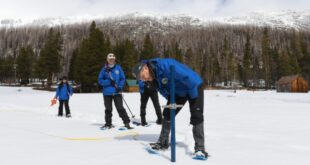Last week Representative Josh Harder (CA-10) and Senator Dianne Feinstein introduced the Snow Water Supply Forecasting Program Authorization Act to establish an airborne snow observatory (ASO) and measurement program within the Department of the Interior. Without accurate readings, water managers could be forced to unnecessarily release water from reservoirs or use it for groundwater pumping, resulting in millions of dollars in financial losses. A previous program run by NASA is no longer in operation, leaving water managers without the public information they need to make smart decisions about their water supplies. The bill would establish a program and provide a total of $15 million for fiscal years 2022 to 2026.
“Many of our rivers are born in the mountains – without accurate snowpack readings, we end up wasting our most precious resource – water – as well as millions of dollars in public funds,” said Rep. Harder. “Creating a unified central program to get our water users the info they need is good for our farmers, good for conservation practices, and will end up saving a ton of money in the long-run.”
“Smarter water management in California starts with more precise readings of our mountain snowpack,” said Senator Feinstein. “Our bill will ensure the federal government continues investing in proven snowpack measurement methods like the airborne snowpack observatory. This will help improve water conservation, supply and delivery forecasts across the Western United States.”
Last December, NASA ended its ASO program that measured snowpack depth ensures continued federal support for the program at the Department of the Interior – a beneficiary of accurate water supplies across the West – helping improve the understanding, management and deployment of snowpack measurement technologies used for seasonal water forecasting.
Conventional survey techniques can only achieve 50 to 90 percent accuracy when measuring snow runoff. The ASO technology developed by NASA can perform more precise measurements, increasing the accuracy to within 96 to 99 percent when paired with conventional techniques, providing an error rate as low as 1 to 3 percent. More precise measurements allow water managers to make better determinations on water allocations – using more water when it’s available and conserving water when it’s not.
The bill is supported by water associations and districts across California, including The Association of California Water Agencies (ACWA), Turlock Irrigation District (TID), Modesto Irrigation District (MID), South Valley Water Association, Friant Water Authority, Family Farm Alliance, Kings River Conservation District, San Juan Water District , City of Folsom, and San Francisco Public Utilities Commission (SFPUC).
 California Water News Daily Your Source For Water News in California
California Water News Daily Your Source For Water News in California


